
Calgary's McKenzie Towne:
Suburb with a Neo-Traditional Facade
Rating of Development
McKenzie Towne is a developing neo-tradition community (also referred to as transit oriented
development, pedestrian oriented development or new urbanism development) on the
southeastern fringe of Calgary (within the city limits). Development information indicates that
McKenzie Towne is the first neo-traditional neighborhood development in Canada. As of
November 1999, the entry sign indicates that the population is between 1,500 and 1,600.
McKenzie Towne is planned to contain 12 villages when complete (15 to 20 years). Currently,
the village of Inverness appears to be nearing completion. Work has started on the village of
Prestwick, and a central commercial area ("High Street") is now open.
McKenzie Towne is located 13 miles southeast of downtown Calgary, immediately east of
Deerfoot Trail (Alberta Route 2, the main north south artery of the province, which is to be
upgraded to freeway standards). A four lane roadway leads into McKenzie Towne and ends at a
large roundabout (traffic circle) which has exits to the Inverness, Prestwick and the High Street
areas. On the round about are a church, which is under construction (McKenzie Towne Church),(1)
and a city of Calgary fire station. Both fit the architectural style of McKenzie Towne well.
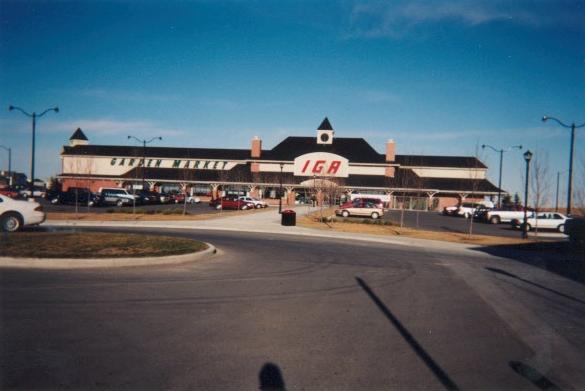 High Street: High Street contains approximately 25 businesses, and 40 are anticipated. The
largest is the IGA supermarket, which appears to be from one-half to two-thirds the size of
typical new supermarkets and is at the end of High Street. The IGA supermarket has an attractive
central front walkway from High Street to the store. Otherwise, the store's surroundings look
similar to that of other suburban supermarkets, with parking on either side of the walkway and to
both sides of the store (200 to 225 spaces are provided). By comparison, a new, much larger
"stand-alone" supermarket in the St. Louis area provides 350-375 parking spaces. The parking at the McKenzie Towne
supermarket is less visually intrusive because some of it is along the sides of the store, and thereby less
obvious. High Street: High Street contains approximately 25 businesses, and 40 are anticipated. The
largest is the IGA supermarket, which appears to be from one-half to two-thirds the size of
typical new supermarkets and is at the end of High Street. The IGA supermarket has an attractive
central front walkway from High Street to the store. Otherwise, the store's surroundings look
similar to that of other suburban supermarkets, with parking on either side of the walkway and to
both sides of the store (200 to 225 spaces are provided). By comparison, a new, much larger
"stand-alone" supermarket in the St. Louis area provides 350-375 parking spaces. The parking at the McKenzie Towne
supermarket is less visually intrusive because some of it is along the sides of the store, and thereby less
obvious.
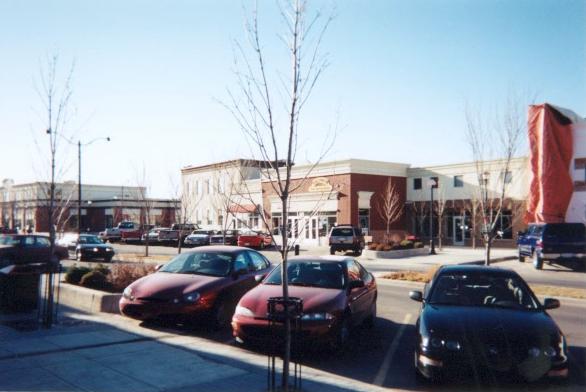 Between the IGA supermarket and High Street is a small roundabout. High Street itself is two
blocks long with businesses on either side and diagonal parking. At the time of the Demographia visit (2 pm on
a November 1999 Saturday), virtually all spaces were taken. Parking is also provided behind all
businesses (300 to 350 spaces), though little of that was occupied. Other businesses include a bank, a video rental store, a coffee
bar, a pizza parlor, a candy store, a florist, a dry cleaner, a liquor store, a pharmacy, a travel
agency and up to ten professional services offices (medical, veterinarian, hair styling, etc.).
During the Demographia visit, it appeared that most of the trips to High Street were by automobile or light truck
and few (if any) were pedestrian.
Between the IGA supermarket and High Street is a small roundabout. High Street itself is two
blocks long with businesses on either side and diagonal parking. At the time of the Demographia visit (2 pm on
a November 1999 Saturday), virtually all spaces were taken. Parking is also provided behind all
businesses (300 to 350 spaces), though little of that was occupied. Other businesses include a bank, a video rental store, a coffee
bar, a pizza parlor, a candy store, a florist, a dry cleaner, a liquor store, a pharmacy, a travel
agency and up to ten professional services offices (medical, veterinarian, hair styling, etc.).
During the Demographia visit, it appeared that most of the trips to High Street were by automobile or light truck
and few (if any) were pedestrian.
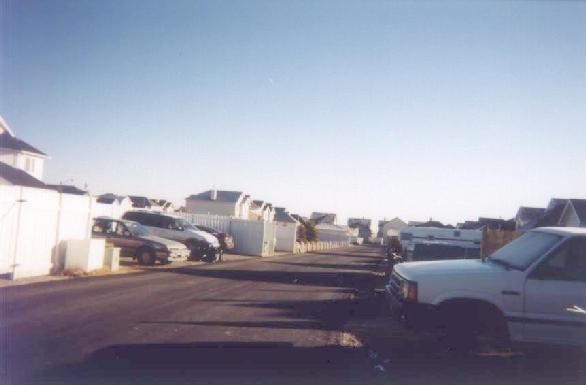 Villages: According to developer brochures, housing styles are Victorian, Craftsman, National
and Georgian. They are located on lots considerably smaller than typical of US suburbs (though other more
conventional new Calgary subdivisions are on smaller lots). The villages contain residential streets that permit parking on both sides. Garages
and parking pads are provided in alleys behind each house. Where two-car garages are provided,
nearly the entire width of the back lot is occupied. At this point, it appears that most of the completed
home sites do not have garages, and that cars are parked either on concrete pads or simply on earth or gravel. Villages: According to developer brochures, housing styles are Victorian, Craftsman, National
and Georgian. They are located on lots considerably smaller than typical of US suburbs (though other more
conventional new Calgary subdivisions are on smaller lots). The villages contain residential streets that permit parking on both sides. Garages
and parking pads are provided in alleys behind each house. Where two-car garages are provided,
nearly the entire width of the back lot is occupied. At this point, it appears that most of the completed
home sites do not have garages, and that cars are parked either on concrete pads or simply on earth or gravel.
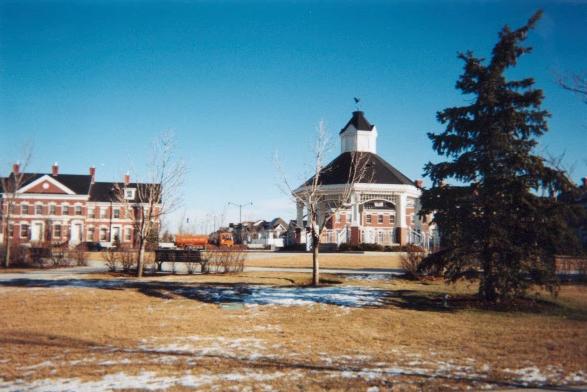 Inverness Village covers approximately one square kilometer (0.38 square miles).
Inverness Village covers approximately one square kilometer (0.38 square miles).
It has an attractive central square (Inverness Square) covering one city block. It is covered
with grass and contains a Victorian design band stand.
Across the street from one corner of Inverness Square is a convenience store, which
includes mail boxes for the residences in Inverness. The same building houses the
McKenzie Towne office, a temporary church location, and at least one professional
office.
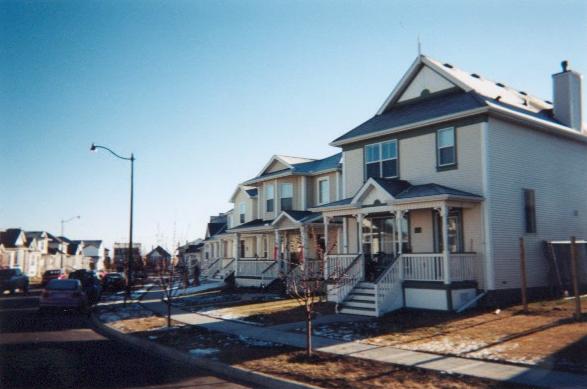
There is a mixture of housing, including apartments, row houses and detached housing.
The row houses are constructed with brick facing and are reminiscent of
pre-20th century
row houses in Toronto, Montreal and
older eastern U.S. cities. Two sides of Inverness Square are faced with row houses, and a
third side has apartments opposite. In the detached housing areas, there is a mixture of
housing sizes, with small houses and large houses next to one another.
Virtually all residences are within walking distance (approximately 0.5 kilometers or 0.25
miles, the transit industry standard) of the Inverness central square and its convenience
store.
Few Inverness houses are within walking distance of High Street.
Prestwick Village is under construction and the village square has not been completed.
According to sales personnel, detached housing will be segregated by size of house in this
village, unlike Inverness. This has been made necessary because of buyer preferences. Some of
the houses in Prestwick are within walking distance of High Street.
Travel Behavior: According to a city of Calgary study:(2)
10.4 percent of McKenzie Towne workers use transit to get to work. This is below the
12.6 percent average for the Calgary metropolitan area (1996).
There are 1.91 vehicles per household. This is well above the Alberta automobile
ownership per household rate of 1.5.
More than 60 percent of trips to "the local store" are by walking. It is presumed that this
question refers to the Inverness Square convenience store, since the High Street shops are
beyond walking distance from most homes. This high proportion of walking trips to the local store does not
necessarily mean that walking trips are replacing vehicle trips. It is possible that a large portion of these trips
are primarily for the purpose of picking up mail at the individual mail boxes located in the local store. In
most US suburban developments, such a trip would not be necessary because mail boxes are located in front of
houses.
Approximately 28 percent of people indicate that they park their vehicles on the street, while more than
70 percent park their cars in the alleys behind the houses (garages and rear driveways).
Comments: McKenzie Towne is considerably larger than Orenco Station, which is being
developed on the Portland (Oregon) urban fringe. While it is has high density in relation to new US
suburban areas, it does not appear to be much more dense than other new suburban developments
in the Calgary area. While the proximity of the convenience store at Inverness Square and the
pleasant walking environment may have reduced vehicle trips, automobiles are still required for
the overwhelming majority of trips, since High Street does not contain a full array of retail
activities. A large strip mall is in the process of opening approximately two miles north of
McKenzie Towne (not a part of the project), along Deerfoot Trail.
There is considerable question, however as to the extent to which the broader objectives of traditional neighborhood
design have been achieved.
McKenzie Towne is designed to be
pedestrian oriented, yet little employment is within walking distance and there is virtually no
employment that is likely to attract the middle income people who purchase homes in the
development.
McKenzie Towne is designed to be transit oriented, yet there is only limited transit service. There
are two daily express bus round trips to downtown, which take 45 minutes (Route #117). There is
also a light rail feeder bus route,
which operates morning and evening service, taking passengers to the Anderson station (Route #416). There is no mid-day service. McKenzie Towne's transit
market work trip share is less than in the balance of Calgary.
Assessment: McKenzie Towne will attract people seeking a life style in a setting
physically reminiscent of the ideolized (if not ideologized) small town. But its success appears to be in architectural
design, nd nothing more.
Even when fully built out, it is likely that nearly as many vehicle trips per capita will be produced in
McKenzie Town, just as has occured at high density residential developments near US rail stations. It is
likely that the overwhelming majority of work, shopping and other trips will take residents outside this
community that is just as inopportunely located relative to Calgary's activity centers as adjacent conventional
suburban developments. Beneath its traditional, retro design core beats the heart of suburbia.
This attractive community is an indication that the home building industry is prepared to provide a greater
degree of diversity in its suburban designs --- something that home buyers could not afford in the less affluent
previous decades of suburban development. Neo traditional communities are justified by the market response of
home buyers and should be neither subsidized nor granted preferential planning status.
1. The sign at the church construction site provides no information as to a
denominational affiliation or other characteristics.
2. As reported in the McKenzie Village newsletter, Your Towne, Fall 1999.
(c) 2000 www.demographia.com --- Wendell Cox Consultancy --- Permission granted to use with attribution.
Demographia is "pro-choice" with respect to urban development.
People should have the freedom to live and work
where and how they like.
|
DEMOGRAPHIA
is an undertaking of
WENDELL COX CONSULTANCY
P. O. Box 841 - Belleville, IL 62222 USA
Telephone: +1.618.632.8507 -
Facsimile: +1.618.632.8538
E-Mail:
enquiries@demographia.com
Demographic Briefs |
New Items |
Book Store |
Subscribe (Free)
Corrections Policy, Rights & Permissions
Related Web Site:

THE PUBLIC PURPOSE
Internet Public Policy Resource
|
|

 High Street: High Street contains approximately 25 businesses, and 40 are anticipated. The
largest is the IGA supermarket, which appears to be from one-half to two-thirds the size of
typical new supermarkets and is at the end of High Street. The IGA supermarket has an attractive
central front walkway from High Street to the store. Otherwise, the store's surroundings look
similar to that of other suburban supermarkets, with parking on either side of the walkway and to
both sides of the store (200 to 225 spaces are provided). By comparison, a new, much larger
"stand-alone" supermarket in the St. Louis area provides 350-375 parking spaces. The parking at the McKenzie Towne
supermarket is less visually intrusive because some of it is along the sides of the store, and thereby less
obvious.
High Street: High Street contains approximately 25 businesses, and 40 are anticipated. The
largest is the IGA supermarket, which appears to be from one-half to two-thirds the size of
typical new supermarkets and is at the end of High Street. The IGA supermarket has an attractive
central front walkway from High Street to the store. Otherwise, the store's surroundings look
similar to that of other suburban supermarkets, with parking on either side of the walkway and to
both sides of the store (200 to 225 spaces are provided). By comparison, a new, much larger
"stand-alone" supermarket in the St. Louis area provides 350-375 parking spaces. The parking at the McKenzie Towne
supermarket is less visually intrusive because some of it is along the sides of the store, and thereby less
obvious.
 Between the IGA supermarket and High Street is a small roundabout. High Street itself is two
blocks long with businesses on either side and diagonal parking. At the time of the Demographia visit (2 pm on
a November 1999 Saturday), virtually all spaces were taken. Parking is also provided behind all
businesses (300 to 350 spaces), though little of that was occupied. Other businesses include a bank, a video rental store, a coffee
bar, a pizza parlor, a candy store, a florist, a dry cleaner, a liquor store, a pharmacy, a travel
agency and up to ten professional services offices (medical, veterinarian, hair styling, etc.).
During the Demographia visit, it appeared that most of the trips to High Street were by automobile or light truck
and few (if any) were pedestrian.
Between the IGA supermarket and High Street is a small roundabout. High Street itself is two
blocks long with businesses on either side and diagonal parking. At the time of the Demographia visit (2 pm on
a November 1999 Saturday), virtually all spaces were taken. Parking is also provided behind all
businesses (300 to 350 spaces), though little of that was occupied. Other businesses include a bank, a video rental store, a coffee
bar, a pizza parlor, a candy store, a florist, a dry cleaner, a liquor store, a pharmacy, a travel
agency and up to ten professional services offices (medical, veterinarian, hair styling, etc.).
During the Demographia visit, it appeared that most of the trips to High Street were by automobile or light truck
and few (if any) were pedestrian.
 Villages: According to developer brochures, housing styles are Victorian, Craftsman, National
and Georgian. They are located on lots considerably smaller than typical of US suburbs (though other more
conventional new Calgary subdivisions are on smaller lots). The villages contain residential streets that permit parking on both sides. Garages
and parking pads are provided in alleys behind each house. Where two-car garages are provided,
nearly the entire width of the back lot is occupied. At this point, it appears that most of the completed
home sites do not have garages, and that cars are parked either on concrete pads or simply on earth or gravel.
Villages: According to developer brochures, housing styles are Victorian, Craftsman, National
and Georgian. They are located on lots considerably smaller than typical of US suburbs (though other more
conventional new Calgary subdivisions are on smaller lots). The villages contain residential streets that permit parking on both sides. Garages
and parking pads are provided in alleys behind each house. Where two-car garages are provided,
nearly the entire width of the back lot is occupied. At this point, it appears that most of the completed
home sites do not have garages, and that cars are parked either on concrete pads or simply on earth or gravel.
 Inverness Village covers approximately one square kilometer (0.38 square miles).
Inverness Village covers approximately one square kilometer (0.38 square miles).
